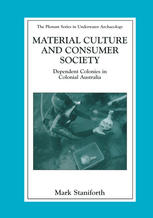

Most ebook files are in PDF format, so you can easily read them using various software such as Foxit Reader or directly on the Google Chrome browser.
Some ebook files are released by publishers in other formats such as .awz, .mobi, .epub, .fb2, etc. You may need to install specific software to read these formats on mobile/PC, such as Calibre.
Please read the tutorial at this link: https://ebookbell.com/faq
We offer FREE conversion to the popular formats you request; however, this may take some time. Therefore, right after payment, please email us, and we will try to provide the service as quickly as possible.
For some exceptional file formats or broken links (if any), please refrain from opening any disputes. Instead, email us first, and we will try to assist within a maximum of 6 hours.
EbookBell Team

0.0
0 reviewsThe establishment of a consumer society in Australia has not been a particularly well explored area of academic inquiry. My interests lie in the concepts and meanings that underlie the material world; ideas like, in the words of Madonna, "I am a material girl and I live in a material world" (terminology taken to be not gender specific), the classic graffiti paraphrasing of Descartes: I shop therefore I am or perhaps simply in the "world of goods" in the more academically respectable terms of Douglas and Isherwood (1979). This book arises out of my longstanding interest in the early colonial period in Australia. In part it represents an extension of the purely "historical" research conducted for my Master's thesis in the Department of History at the University of Sydney which explored aspects of the diet, health and lived experience of con victs and immigrants during their voyages to the Australian colonies within the timeframe 1837 to 1839 (Staniforth, 1993a). More importantly, it is the culmina tion of more than twenty-five years involvement in the excavation of shipwreck sites in Australia starting with James Matthews (1841) in 1974, through the test excavation of William Salthouse in 1982, continuing with my involvement between 1985 and 1994 in the excavation of Sydney Cove (1797) and most recently with shore-based whaling stations and whaling shipwreck sites. In this respect, this book may be seen as an example of what Ian Hodder (1986, p.